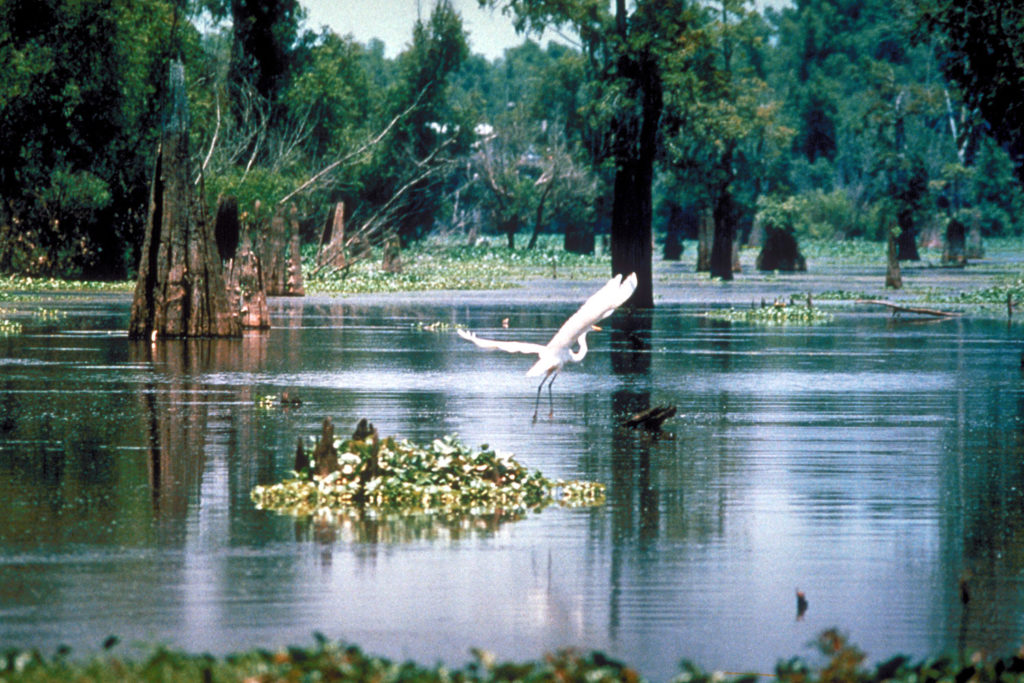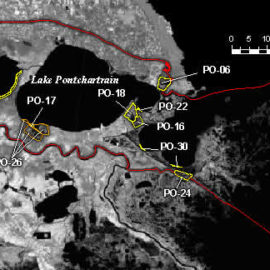
Officials drew the Atchafalaya Basin down and then the rain stopped.
It was February 2019 when Ben Pierce had his drone out in Henderson Lake in the Atchafalaya Basin when the thing starting blinking red to indicate that something was wrong. The drone, an older DJI Phantom that he estimated was valued at $1,500-$2,000, hit a cypress tree and went into the water. Water level that day was as high as 10 feet in some areas, but it was still too cold to go in after it. Pierce, who is executive director of McGee Swamp Tours in Henderson, made a mental note and waited. When officials in St. Martin Parish enacted the drawdown of the lake earlier this year and the lack of rain in September and October helped the water level get the lowest it’s been in decades, Pierce went on a mission to find that drone three years after it crashed. The water level where it went down had receded so much that the lake floor had hardened with cracks up to 10 inches. “I kind of felt like an archaeologist at a dig site,” he said. “We were able to get it out of the mud. It was pretty nasty. Everything was rusted and brittle. When I got home, I put the SD card in the reader, and the SD still worked. “Talk about a smile on my face that didn’t go away for a couple of days. Big props to Lexar for making an SD card that can survive three years in the swamp.”
nola.com
The drawdown of the water level went on for four months.
The water level in the lake reached historic levels last month as parish officials in coordination with the state Department of Wildlife and Fisheries enacted a drawdown July 1 by opening the locks near Butte La Rose to manage the aquatic vegetation in the lake and enhance fisheries habitat. It ended Nov. 1 as the water level at Lake Pelba got down to six feet, but in many areas of Henderson Lake and the areas along Interstate 10 the water receded almost completely. It’s a process parish officials have tried each year since 2014, but often it was unsuccessful due to rainfall in what is normally a dry season in south Louisiana. Not since 2014 has a drawdown been successful, Parish President Chester Cedars said. This time, however, the weather cooperated. After a rainy August, much of south Louisiana went without measurable rain from early September into October. In Baton Rouge, total rainfall in September was 3.5 inches below the normal value of 4.42 inches, according to the National Weather Service. “A lot of the old-timers have told me it’s been since their childhood that they’ve seen the basin this low,” he said. “Since the drawdowns began in 2014, I would say this is the only drawdown that was reasonably successful. In years past we always had high-water events that just impacted significantly the drawdown, but that did not happen this year. “I like to joke with people and say that when Donald Trump was elected president, he promised to drain the swamp. I don’t think he was successful, but in St. Martin Parish, we actually drained it.”
The lower levels are to control the invasive plants that are in the basin.
The lower levels allows for the control of three invasive plants — water hyacinth, hydrilla and giant Salvinia — that rob the water of nutrients and impedes navigation. Hydrilla is the worst of the three by far, Henderson Mayor Sherbin Collette said. That plant germinates in September and October, and lowering the water level can help control it. According to LSU Ag Center, hydrilla can take over a habitat by growing so dense it can block out sunlight and reduce oxygen in the water. “To completely eradicate it is almost impossible,” Collette said. “A few years back, the hydrilla has completely covered the flats area (along I-10). It was solid from the top of the water to the bottom. It depletes the oxygen beneath it. At one point nothing can live in it. The sun can’t hit it, and the wind can’t put oxygen in it.” The drawdown will also help prepare for the basin for any high water that may come in the future from the Mississippi River. The whole area is filling with sand and silt over the years, said Dean Wilson, executive director and founder of Basinkeeper Atchafalaya, a group whose mission is to protect and restore the swamp.
The sediment has raised the level of the basis so it holds less water.
The elevation is higher than it was 10 years ago in many places in the basin, which means it can take less water. “One thing about the water being down low we can see how bad the sediment problem is,” he said. “It’s real, real bad. The basin is designed to handle mega Mississippi (River) floods. You fill the basin, and you lose flood capacity. If you have a major flood and the basin cannot handle that flood, you have over 150 industrial plants between Baton Rouge and New Orleans that can go under.” Most people who use the basin regularly are understanding of the process, Pierce noted, while the businesses that offer swamp tours have been able to continue operating. It’s given a chance to see the area in a different light, and areas that was once covered in several feet of water were converted to hiking areas with ground cracking in such large portion it resembled a giant puzzle. Much like the lower Mississippi River, the low level caused a variety of items to surface, including sunken boats, buckets and beverage bottles that have been out of production for years. And it definitely got people talking. “It’s very arid,” Pierce said. “Knowing that this is an aquatic environment, it just feels otherworldly to me. It’s just so different than what I’m used to seeing. I try my very, very best to never use something negative to describe this place. It’s an amazing wilderness that has so many benefits to the rest of the country.”
There is a positive reason for lowering the water but this year nature did not cooperate in filling it back up.

